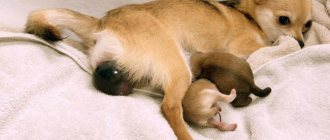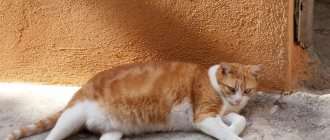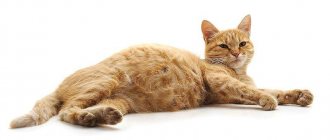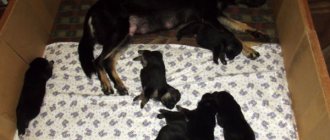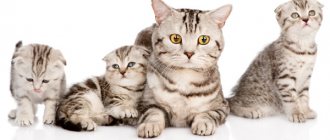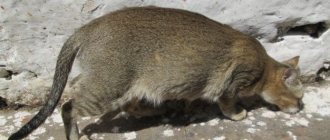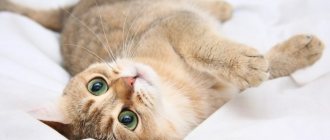When bringing an affectionate cat into your home, it is worth remembering that at any moment a healthy animal can give birth to offspring. If you don’t want to have kittens and then think about how to get rid of them, it’s better to take action in advance. If you are not against expanding the cat family, you need to study information about cat pregnancy, caring for it and the characteristics of childbirth.
- how to tell if a cat is pregnant
- How long does a cat's pregnancy last?
- gestational age depending on breed
- embryo development by trimester
- How does a cat's pregnancy proceed externally?
- caring for a pregnant cat
- preparation for childbirth
- a little about how cats give birth
How to tell if a cat is pregnant
Owners of an adult animal do not always understand whether the cat is pregnant or not. Tests for pets have not yet been invented, so you have to navigate by obvious and subtle signs of pregnancy. What features are observed in the behavior of the pet, who, most likely, will soon become a mother:
- the cat suddenly became very affectionate, constantly demanding attention, which was not observed before;
- a lover of walks suddenly turned into a homebody;
- a pet eats for two;
- The cat began to go to the toilet more often.
However, all these are indicative signs that are noticed by attentive owners during the pregnancy of their pets. If we talk about real physiological changes, they appear approximately three weeks after a successful mating.
The nipples are the first to change: they rise and become distinctly pink. A little later, the cat may develop symptoms of toxicosis: morning vomiting. In the fifth week, the animal clearly gains weight. After another seven days, the mammary glands swell as they fill with milk. And of course, the pet is not in heat, and she is not at all attracted to cats.
Deworming
During pregnancy, a cat cannot be dewormed. All anthelmintic drugs are toxic and can harm the embryos. It is necessary to take care of getting rid of internal parasites 7 days before mating.
If this procedure was not carried out in advance, then deworming is done 1 month after birth. The cubs also undergo anthelmintic treatment together with the mother. The cat is given an anthelmintic drug that can be used during lactation, and kittens are given a special suspension.
How long does a cat's pregnancy last?
Do you know the expression “only cats are born quickly”? It must be said that it has a rational basis. The minimum gestation period for a cat is only 53 days. The maximum established period is 72 days. The term varies depending on the number of kittens being carried, the breed and even the length of the animal’s fur. Traditionally, the number of cubs does not exceed 6. In rare cases, more than 6 fetuses can be seen in one litter.
It has been established that long-haired cats usually carry babies for a full term, because... all 72 days (9 weeks). But short-haired beauties are controlled faster, in just 58-68 days. It is important to know that a more rapid pregnancy signals the presence of any pathologies in the development of kittens or related to the health of the mother herself.
When considering the issue of gestation periods, one cannot help but take into account external factors. Pregnancy can be premature or post-term. The shortening of the period, in particular, is often influenced by stress, careless jumping (especially in recent weeks), poor nutrition or illness. Therefore, in order for kittens to be born healthy, the cat must be taken care of throughout its entire life.
Nutritional Features
Nutritional needs change throughout pregnancy. The first two weeks, when appetite increases slightly, the daily portion is increased by 10%. In this case, the entire volume of food is divided not into 2 meals, as usual, but into 4–5. From 3 to 7 weeks, the amount of feed is doubled from the original. Over the last fortnight, my appetite has decreased slightly as the fruits put pressure on my internal organs.
Pregnant cats have a good appetite
The diet should not contain foods from the human table, especially those containing chemical additives - chips, sausages, smoked meats, including fish. This is harmful to all domestic animals, and their benefits for humans are questionable.
Nomes for feeding cats
Dry or natural food?
Cat breeders have not yet come to a consensus on which food is better - industrial or natural. But they agree on one thing: if it is ready-made food, then it must be the highest quality available. Switching to a different type of diet will do more harm than good.
Cat breeders never tire of arguing about which food is best.
Dry food familiar to cats is gradually being replaced with analogues for pregnant women. If a special product cannot be found, then simply increase the portion as described above. Experienced breeders recommend special foods for pregnant cats:
Royal Canin Queen
Acana Pacifica
Bozita
Josera Minette for kittens and nursing cats
These brands fall into the holistic and premium categories. They contain a sufficient amount of fat, protein, and amino acids to provide the expectant mother with energy for pregnancy and strengthen her immune system.
Kitten food is one of the options for complete nutrition for a pregnant or lactating cat.
In addition to the main diet, from time to time you can pamper your cat with natural products - meat, cottage cheese, yogurt. But then this is a delicacy, not the main food.
Many sources on cat nutrition note that it is not worth giving additional vitamins and minerals, since everything necessary is included in the product. Only a veterinarian can determine the possible need for supplements.
Natural nutrition
Breeders pay special attention to the natural nutrition of the cat. table 2
Qualitative composition of a pregnant cat's diet
Table 2. Qualitative composition of the diet of a pregnant cat.
| Squirrels | 25 |
| Carbohydrates | 25 |
| Fats | 12 |
| Cellulose | 2-3 |
| Minerals | 6 |
| Water | 29-30 |
Cats usually refuse plant foods. But if you grind it in a blender to a puree and mix it with meat products, then its taste buds can be deceived. You should not cut food into cubes, since only meat pieces will be selected from the plate.
A cat needs the following products:
- dietary meat - chicken, veal, beef (can be raw, but only fresh and high quality);
- sometimes - boiled fish;
- eggs - 2 pcs. in Week;
- low-fat dairy group - cottage cheese, yogurt, sour cream, cream, yogurt;
- cereals - oatmeal, rice, buckwheat;
- jelly, boiled cartilage.
Natural products are necessary for a pregnant cat
For constipation, give the cat beets and increase the amount of vegetable fat. But they are excluded or the dose is reduced after the condition has stabilized.
Herbal remedies for pregnant cats
Breeders recommend giving cats an infusion of raspberry leaves. It is prepared from a tablespoon of dry raw materials and a glass of boiling water, left for 15 minutes and filtered. Give a tablespoon 2 times a day from the beginning to the end of pregnancy. This will help bear healthy offspring and simplify the birth process.
In the second half of pregnancy, pre-scalded nettle leaves are added to the drink. These greens promote milk production.
Nettle decoction increases the amount of breast milk
Vitamin supplements for a pregnant cat
It is necessary to ensure the presence in the diet of vitamins A, D, E, B1, B6, B1, as well as calcium, phosphorus, iron, iodine. Taurine, a sulfur-containing amino acid, is extremely important. If the diet is prepared correctly and is not monotonous, the body receives most of these elements from food. But with an unbalanced diet, vitamin preparations with the listed substances are necessary.
The following brands offer vitamin complexes for pregnant cats:
- Beaphar (Top 10 Cat, Salvical, Irish Cal);
- Brewers Yeast 8 in 1;
- Anivital FeliImmun and others.
Vitamin preparations will provide vital elements
Embryo development by trimester
So, we have decided on the number of days. Maximum – 72 days, or 9 weeks. These weeks, in turn, are divided into 3 trimesters, each of which accounts for 3 weeks, respectively.
First trimester
Considering that in one pregnancy a cat usually gives birth to from 1 to 6 kittens, it is not difficult to guess that during a meeting, fertilization of not one, but several eggs occurs at once. Fertilized eggs, future kittens, attach to the walls of the uterus the next day. Moreover, depending on the sex of the future baby, zygotes occupy predetermined places in the branches of the uterus. The place where the fetus clings is called the chorion. The placenta forms around it.
In the first week after conception, the size of the fetus can be compared to a speck of dust, but by day 15 the size of the embryo is already 10 mm. By day 18, you can see the tiny paws of the future kitten. Closer to three weeks, internal organs actively begin to develop inside the fetus.
Second trimester
The second trimester is the time for kittens to grow bone and muscle mass. At the same time, the brain begins to grow, the hormonal system in the small body begins to develop, and the formation of the genital organs begins. It is during this period that the fetus takes on the usual feline shape, and the formation of the muzzle is completed. The kitten grows small soft claws.
Third trimester
The size of one kitten by the beginning of the third trimester reaches about 8 cm. Just before birth, the baby usually grows another 5 cm. As for internal development, it is coming to an end, the external characteristics of the animal become more obvious: the tail grows, the skin thickens body, ears grow. At the same time, wool appears, and a little later it acquires the required color.
Caring for a young mother and kittens
In the first days, it is not advisable to get too close to the nest, much less pick up the babies. A mother will almost always act aggressively in an attempt to protect her children, even if she previously trusted the person. During this time, you need to provide food, water and a tray nearby, since cats do not go far from the nest.
A cat that has given birth constantly feeds its babies, so it still needs extra nutrition. In the first days, kittens are completely dependent on mother's milk, but after a month it is necessary to introduce complementary foods in the form of a special diet for babies. The need for breast milk decreases, almost disappearing by three months.
How does a cat's pregnancy proceed externally?
In the first trimester, a pet's pregnancy can be completely invisible to the owners. Even an experienced veterinarian will not be able to determine it at this time. But by the end of this period, the embryos in the abdomen have already grown to a decent size - 1-2 centimeters, so physiological changes begin to occur. There is, as a rule, one exception - if you know the exact date of mating between a cat and a cat.
In the second trimester, hormonal levels change, which leads to morning sickness. The belly is growing, but for now the owners may not notice it with the naked eye. But a visit to the veterinary clinic will answer many questions: the doctor will be able to establish the fact of pregnancy.
The second half of the gestation period is the most active in terms of changes in the body. After the fourth week, you can feel the kittens with your palm. If there are a lot of them in the tummy, then the animal’s posture will change. The pet will take the shape of a “donkey” due to the sagging of the back.
In the last days before giving birth, the cat begins to show a desire to nest. She sleeps a lot, and her vigorous appetite gives way to a sluggish interest in food.
Fighting skin parasites
It is better to eliminate ticks, fleas and other parasites that live in the coat and on the skin before mating. These insects are carriers of infections that can cause miscarriage during pregnancy. It is quite difficult to carry out preventive measures during pregnancy. Most drugs against parasites are toxic; their active components can cross the placenta. As a result, babies may die in utero or be born with developmental defects.
It is believed that during pregnancy, wool can only be treated with Stronghold. This is the most gentle remedy. However, it is still better to consult a veterinarian about this.
